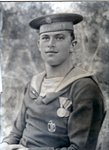The tenth day of February, 1916. Today, we had our first dive within the harbor. Right after breakfast the Torpedo Master took us aside and began in a solemn tone, "So that you know it, today we start with the diving practice. Be very careful that you don't do any foolish things. The Commanding Officer is going to run you through properly on the steering and on the valve stations. Show him that you learned and know something. Don't put me to shame."
"Torpedo Master, Sir!" I replied, "We are going to pull ourselves together."
At eight o'clock came the order. "All men on deck!" The Commander, Line ship Lieutenant Fandrich, Second Officer, Frigate Lieutenant Thot, Third Officer, Frigate Lieutenant Pospischil and Torpedo master Scholer. Then the torpedo instructors, Dzcmicek, Lehar, Ksoblar and Putigna. Also Machine Master Egger and Machine Mate Perno, Electro Master Brodinger, Electrician Gruner, Torpedo Foreman Stieber and...my humble self.
The Commander asked us a few questions first. Then the order sounded, "To the anchor station!" A couple of short commands, a few swiftly executed actions and the boat slid silently out of the cove. We headed first toward Castel Nuovo. You could hardly hear the exhaust of the diesel motor. A red signal flag was fastened to the periscope so the other ships could recognize that we are not an enemy ship when only the periscope shows. Then came the command, "Ready to dive!" All men had to go inside the boat and to their diving stations. Only the Commander remained yet on the tower. Not long before he too came down. Then it started. I was assigned to the valve station for venting operations. Then, "Dive tanks open!" it came down from the tower. The man at the dive tank valves turned the spindles around and I tore the vents open. The air hissed as it escaped out the vent pipes and the sea water gushed into the dive tanks.
The hands on the big depth manometer swung around and showed how rapidly the boat dived: 1-2-3-4-5-6-7-8-9-10 meters. "Dive tanks closed!" followed by, "Periscope up!" sounded from the tower. The dive tanks were closed and I closed the vent valves. The periscope whirred as it rose up. Now the boat was in a position where it could be kept constant only with the help of the regulator tanks. If it was too heavy, some water was pumped out. If it was too light, then some more water was allowed to flow in. The trim tanks and the depth-steering took care of balance. One of each was located fore and aft. The amount of water in them remained the same. They did not add more weight to the boat. The water was merely pumped from one to the other to lower the front or rear of the boat to facilitate the depth-steering.
For the two of us, one more thing to consider was the direction-steering. But that was no mystery since both of us did that on the torpedo boats. The reading of the gyroscope compass, with its division into degrees, was easier than the magnetic compass during calm seas. But in rough seas it could mean hell for the helmsman. This beast showed the tiniest deviation of the boat from course. When the boat was rolling and thumping, the needle danced around like crazy. If you got nervous, it would cause you a lot of pain and you wished this sensitive apparatus would go to the devil. There was also the magnetic compass onboard, but it never worked properly and no adjusting helped.
Stefan and I took all the instructions to heart and even studied in our free hours the duties we had to learn. Soon we could firmly master the procedures. We were ready to go into action with tense anticipation. We did not have to wait long to satisfy our wishes and it would require of us all possible efforts.
Thursday, November 10, 2011
Subscribe to:
Post Comments (Atom)


No comments:
Post a Comment